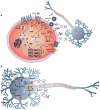Role of mu-opioids as cofactors in human immunodeficiency virus type 1 disease progression and neuropathogenesis
- PMID: 21735315
- PMCID: PMC3757547
- DOI: 10.1007/s13365-011-0037-2
Role of mu-opioids as cofactors in human immunodeficiency virus type 1 disease progression and neuropathogenesis
Abstract
About one third of acquired immunodeficiency syndrome cases in the USA have been attributed to the use of injected addictive drugs, frequently involving opioids like heroin and morphine, establishing them as significant predisposing risk factors for contracting human immunodeficiency virus type 1 (HIV-1). Accumulating evidence from in vitro and in vivo experimental systems indicates that opioids act in concert with HIV-1 proteins to exacerbate dysregulation of neural and immune cell function and survival through diverse molecular mechanisms. In contrast, the impact of opioid exposure and withdrawal on the viral life cycle and HIV-1 disease progression itself is unclear, with conflicting reports emerging from the simian immunodeficiency virus and simian-human immunodeficiency virus infection models. However, these studies suggest a potential role of opioids in elevated viral production. Because human microglia, astrocytes, CD4+ T lymphocytes, and monocyte-derived macrophages express opioid receptors, it is likely that intracellular signaling events triggered by morphine facilitate enhancement of HIV-1 infection in these target cell populations. This review highlights the biochemical changes that accompany prolonged exposure to and withdrawal from morphine that synergize with HIV-1 proteins to disrupt normal cellular physiological functions especially within the central nervous system. More importantly, it collates evidence from epidemiological studies, animal models, and heterologous cell systems to propose a mechanistic link between such physiological adaptations and direct modulation of HIV-1 production. Understanding the opioid-HIV-1 interface at the molecular level is vitally important in designing better treatment strategies for HIV-1-infected patients who abuse opioids.
Conflict of interest statement
Figures


Similar articles
-
Emergence of CD4 independence envelopes and astrocyte infection in R5 simian-human immunodeficiency virus model of encephalitis.J Virol. 2014 Aug;88(15):8407-20. doi: 10.1128/JVI.01237-14. Epub 2014 May 14. J Virol. 2014. PMID: 24829360 Free PMC article.
-
Modeling the Effects of Morphine-Altered Virus Specific Antibody Responses on HIV/SIV Dynamics.Sci Rep. 2019 Apr 1;9(1):5423. doi: 10.1038/s41598-019-41751-8. Sci Rep. 2019. PMID: 30931971 Free PMC article.
-
Interferon-Inducible CD169/Siglec1 Attenuates Anti-HIV-1 Effects of Alpha Interferon.J Virol. 2017 Oct 13;91(21):e00972-17. doi: 10.1128/JVI.00972-17. Print 2017 Nov 1. J Virol. 2017. PMID: 28794041 Free PMC article.
-
Modulation of intracellular restriction factors contributes to methamphetamine-mediated enhancement of acquired immune deficiency syndrome virus infection of macrophages.Curr HIV Res. 2012 Jul;10(5):407-14. doi: 10.2174/157016212802138797. Curr HIV Res. 2012. PMID: 22591364 Free PMC article. Review.
-
Opiate drug use and the pathophysiology of neuroAIDS.Curr HIV Res. 2012 Jul;10(5):435-52. doi: 10.2174/157016212802138779. Curr HIV Res. 2012. PMID: 22591368 Free PMC article. Review.
Cited by
-
Substance abuse, HIV-1 and hepatitis.Curr HIV Res. 2012 Oct;10(7):557-71. doi: 10.2174/157016212803306023. Curr HIV Res. 2012. PMID: 22973853 Free PMC article. Review.
-
Drugs of Abuse in HIV infection and neurotoxicity.Front Microbiol. 2015 Mar 24;6:217. doi: 10.3389/fmicb.2015.00217. eCollection 2015. Front Microbiol. 2015. PMID: 25852673 Free PMC article. No abstract available.
-
Opioids and Opioid Maintenance Therapies: Their Impact on Monocyte-Mediated HIV Neuropathogenesis.Curr HIV Res. 2016;14(5):417-430. doi: 10.2174/1570162x14666160324124132. Curr HIV Res. 2016. PMID: 27009099 Free PMC article. Review.
-
HIV-1 gp120 and drugs of abuse: interactions in the central nervous system.Curr HIV Res. 2012 Jul;10(5):369-83. doi: 10.2174/157016212802138724. Curr HIV Res. 2012. PMID: 22591361 Free PMC article. Review.
-
High levels of self-reported prescription opioid use by HIV-positive individuals.AIDS Care. 2016 Dec;28(12):1559-1565. doi: 10.1080/09540121.2016.1198746. Epub 2016 Jun 20. AIDS Care. 2016. PMID: 27320493 Free PMC article.
References
-
- Belcheva MM, Szucs M, Wang D, Sadee W, Coscia CJ. mu-Opioid receptor-mediated ERK activation involves calmodulin-dependent epidermal growth factor receptor transactivation. J Biol Chem. 2001;276:33847–33853. - PubMed
Publication types
MeSH terms
Substances
Grants and funding
- DA19807/DA/NIDA NIH HHS/United States
- R01 DA015014/DA/NIDA NIH HHS/United States
- NS46263/NS/NINDS NIH HHS/United States
- R01 DA019808/DA/NIDA NIH HHS/United States
- DA19808/DA/NIDA NIH HHS/United States
- NS32092/NS/NINDS NIH HHS/United States
- T32 MH079785/MH/NIMH NIH HHS/United States
- R01 NS032092/NS/NINDS NIH HHS/United States
- R37 DA015014/DA/NIDA NIH HHS/United States
- DA15014/DA/NIDA NIH HHS/United States
- 5T32MH079785/MH/NIMH NIH HHS/United States
- R01 NS046263/NS/NINDS NIH HHS/United States
- R01 DA019807/DA/NIDA NIH HHS/United States
LinkOut - more resources
Full Text Sources
Medical
Research Materials

